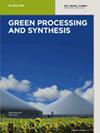利用埃洛石粘土吸附 Co2+ 离子并通过电沉积法回收的能力研究
IF 3.8
4区 工程技术
Q2 CHEMISTRY, MULTIDISCIPLINARY
引用次数: 0
摘要
在环境研究中,在发现重金属吸附方法的同时,还必须了解这些重金属从吸附材料中解吸、回收及其再利用的过程。本研究利用从越南 Thach Khoan 获得的埃洛石(HAL)粘土去除水溶液中的 Co2+ 离子,并研究了不同因素对 Co2+ 吸附特性的影响。确定的最佳条件为:每 50 mL 溶液中含 0.8 g HAL,初始 Co2+ 浓度为 40 mg-L-1,接触时间为 80 分钟,pH0 为 6.09,室温为 30°C。在这些条件下,吸附效率和吸附容量分别为 76.358 ± 0.981% 和 1.909 ± 0.025 mg-g-1。吸附过程遵循 Langmuir 吸附等温线,最大单层吸附容量为 3.10206 ± 0.13551 mg-g-1,并表现出伪秒阶动力学模型。利用电化学方法,以氯化胆碱和尿素(reline)为基础的深共晶溶剂进行了解吸实验。结果表明,在 60°C 条件下,使用 7.5 mA 的外加电流,5 小时后可通过电沉积回收 94.11% 的钴金属。解吸过程结束后,HAL 材料成功再生。本文章由计算机程序翻译,如有差异,请以英文原文为准。
Research on the adsorption of Co2+ ions using halloysite clay and the ability to recover them by electrodeposition method
In environmental research, along with discovering methods for adsorbing heavy metals, it is essential to comprehend the processes of desorption and recovery of these heavy metals from adsorbent materials and their reuse. In this study, halloysite (HAL) clay, obtained from the Thach Khoan, Vietnam, was utilized for the removal of Co2+ ions from an aqueous solution, and the influence of different factors on the adsorption properties of Co2+ was investigated. Optimal conditions determined were 0.8 g HAL mass per 50 mL of solution, initial Co2+ concentration of 40 mg·L−1, contact time of 80 min, pH0 of 6.09, and room temperature of 30°C. Under these conditions, the adsorption efficiency and capacity obtained were 76.358 ± 0.981% and 1.909 ± 0.025 mg·g−1, respectively. The adsorption process followed the Langmuir adsorption isotherms, with a maximum monolayer adsorption capacity of 3.10206 ± 0.13551 mg·g−1, and exhibited a pseudo-second-order kinetic model. Desorption experiments were conducted using the electrochemical method with a deep eutectic solvent based on choline chloride and urea (reline). The results demonstrated that 94.11% of the Co metal could be recovered through electrodeposition after 5 h, using an applied current of 7.5 mA at 60°C. The HAL material was successfully regenerated following the desorption process.
求助全文
通过发布文献求助,成功后即可免费获取论文全文。
去求助
来源期刊

Green Processing and Synthesis
CHEMISTRY, MULTIDISCIPLINARY-ENGINEERING, CHEMICAL
CiteScore
6.70
自引率
9.30%
发文量
78
审稿时长
7 weeks
期刊介绍:
Green Processing and Synthesis is a bimonthly, peer-reviewed journal that provides up-to-date research both on fundamental as well as applied aspects of innovative green process development and chemical synthesis, giving an appropriate share to industrial views. The contributions are cutting edge, high-impact, authoritative, and provide both pros and cons of potential technologies. Green Processing and Synthesis provides a platform for scientists and engineers, especially chemists and chemical engineers, but is also open for interdisciplinary research from other areas such as physics, materials science, or catalysis.
 求助内容:
求助内容: 应助结果提醒方式:
应助结果提醒方式:


